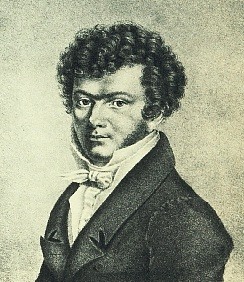Ferdinand Ries (28 November 1784 (baptised) – 13 January 1838) was a German composer.
Ries was a friend, pupil and secretary of Ludwig van Beethoven. He composed eight symphonies,
a violin concerto, eight piano concertos and numerous other works in many genres,
including 26 string quartets.
Piano Concerto no. 5 in D major, op. 120, "Concerto Pastoral"
Ferdinand Ries composed the Symphony No. 5 in D minor, Opus 112, in London in 1813. It was the second symphony Ries wrote. It was first performed at a Philharmonic Society concert on 14 February 1814. In 1823, Breitkopf & Härtel published the work together with piano solo, piano duet and chamber arrangements.
Scored for flute, 2 oboes, 2 bassoons, 2 horns, 2 trumpets, 3 trombones, timpani and strings, the piece is in four movements:
- Allegro
- Larghetto con moto quasi andante
- Allegro assai
- Allegro
Inspired by Ludwig van Beethoven's Symphony No. 5 in C minor, Ries's Fifth uses the rhythm of Beethoven's famous "Fate" motif with different pitches.[1][2] The piece has been recorded by the Zurich Chamber Orchestra conducted by Howard Griffiths on the Classic Produktion Osnabrück label.
Christopher Hinterhuber (piano), Bournemouth Symphony Orchestra, Uwe Grodd (conductor)
“The grand opening tutti[전 합주] of the D Major Concerto Pastoral could be by Beethoven; there are
even a few brief melodic hints of Beethoven’s “Pastoral” and Ninth symphonies , but as soon as the
piano enters, the romantic keyboard style takes over.
Ries includes solo horn passages in both the second and third movements, the first of which functions
as a link between the movements. These solos—in reality they are horn calls—employ the type of yodelling motives that are an important element of the pastoral style.
The lovely second movement Andantino is also remarkable for its orchestration: Ries omits the violins and instead employs a seductive[매혹적인], dark-hued combination of solo horn, solo cello, two bassoons, divisi violas, cellos and basses.
Like all Ries’s concerto finales, this movement exhibits an intriguing mix of brilliant virtuoso display, delicate lyricism and gruff, powerful orchestral outbursts.”[2019. 11. 12. 1차]
According to Allen Bradley in the liner notes to the Naxos recording, the composer's manuscript is undated making it difficult to determine exactly at what point the composer started working on this concerto. However the works dedication to Prince Oscar of Sweden, suggests that he started work on the concerto during his time in Sweden and worked intermittently on it, along with revisions to the Piano Concerto Op. 55 until around 1815-16. This would make the concerto the sixth of the composers eight piano concertos to be written. The concertos publication in 1823 came at a time when Ries was retiring from active performing and so no longer needed to keep secret the works he relied on in performance.
* 베토벤의 황제 협주곡[피아노 협주곡 5번]을 많이 연상케 한다.
'♣ 음악 감상실 ♣ > - 페르디난드 리스' 카테고리의 다른 글
| Ferdinand Ries - Piano Concerto No. 7, Op. 132 (1823) (0) | 2020.11.16 |
|---|---|
| Ferdinand Ries - Piano Concerto No.6, Op. 123 (1806) (0) | 2020.11.16 |
| Ferdinand Ries: Introduction et Rondo Brillant, Op.144 (0) | 2020.11.14 |
| Ferdinand Ries - Piano Quintet In B Minor Op.74 (0) | 2020.11.13 |
| Ferdinand Ries - Piano Trio No. 4, in C minor Op. 143 (1826) (0) | 2020.11.09 |
